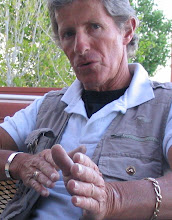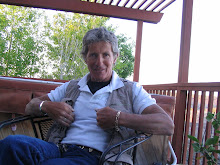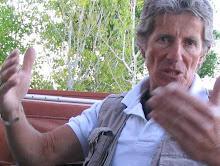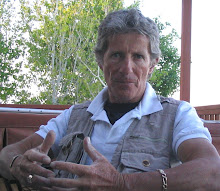Cooper helped Awerbuck immigrate to the U.S. from his native South Africa 25 years ago, and he has been instructing high-level firearms classes full-time ever since. Awerbuck teaches at major firearms training centers around the country under the auspices of his own Yavapai Firearms Academy.
After spending a recent week watching Awerbuck work during a defensive pistol class at Gunsite, I wanted to get him off the range for a few hours and ask him some questions. We met for dinner a few miles from Gunsite at the Little Thumb Butte Bed & Breakfast, a favorite retreat for Gunsite students, where owner/hostess Ann Harrington served us a wonderful home-cooked meal on a private balcony overlooking endless juniper-dotted hills with a river running through them.
Among his other personality attributes, Awerbuck is a very humble guy. If there is a gulf between the way he thinks and the behavior and attitude of society in general, Awerbuck is willing to admit that maybe he’s the one that’s crazy. From what I’ve seen, however, it’s clearly the other way around.
I asked him what the toughest thing was about teaching people to shoot.
“For beginners, probably realizing it’s easier than they think it is. They tend to overthink the problem. For experienced people, trying to correct ingrained habits they’ve had for years. That’s much harder.”
Q: A lot of guys can teach the mechanics of shooting, which is fairly simple, don’t you think?
A: It is extremely simple. It’s sights, trigger, follow-through. That’s all it is, that’s all it ever has been. Once the firing grip, the stance, the shooting platform and that type of thing are worked out. The actual operation of sending a projectile downrange on a steady target is sights, trigger, follow-through. Most people try to shoot too accurately and overthink the problem. They try for 103 percent and wind up with 40 percent. My draw to the game is the psychology of it, the whys and wherefores. It always has been.
Q: I just read your book, Tactical Reality (Paladin Press 1999), and you talk a lot about that. I especially liked your chapters dealing with heart and mind. That’s a pretty deep subject.
A: It’s real deep for a young kid. But none of this is new. This stuff is 5,000 years old. It’s the same mindset as the Samurai, the Ninja, Genghis Kahn, the Romans, the Greeks, the Spanish, you can just keep on going back through the ages. It was always the same thing.
Q: Why do some people not get it?
A: Some of the people who don’t get it are highly professional, skilled people -– like a commercial pilot, a neurosurgeon, somebody who cannot afford to make the slightest slip in his normal occupation, so he overthinks every single thing when he’s firing a weapon. They’ll “what if” things to death. Other people who don’t get it are not really fighting-oriented. From what I’ve seen, I think it’s a societal thing. Let’s face it, in North America you can pretty much buy anything you want. So people tend to think that if you pay a certain amount of money to be taught how to do something with a firearm, the net result at the end of the day is that you will be able to do it. It’s like paying to have your brakes fixed, or paying for an appendectomy. They’re paying for a service and they expect it to be done. They don’t figure they need any ability themselves or that they’re going to have to put some of themselves into it.
Q: What do the non-warriors do when they get in trouble?
A: They will probably have their pistol taken away, because really and truly deep down inside they are not prepared to take life even in defense of their own. So they’ll probably have their pistol taken away, get shot with their own pistol, and then the crook will leave with their pistol and shoot another person with it.
Q: A lot of instructors have told me that their toughest problem is that something like eighty percent of people are not capable of shooting somebody.
A: Not looking into their faces, looking into their eyes from six feet away and doing it. A lot of people will go out and shoot Bambi in the Coconino Forest and not think twice about it but couldn’t bring themselves to do it to a human, who just happens to be an animal walking on his back legs.
Q: Do you see any parallels between defensive pistol shooting and dangerous-game hunting?
A: Sure, as far as the adrenal dump, the chemical cocktail. Bambi is just pipes, wires, meat, bone, gristle, blood, the same as the rapist in the back alley.
Q: But I’m talking about dangerous game. The hunter is not afraid of Bambi.
A: If I’m afraid of you, in fear of my life, I need to do something about it. But we’ve grown up in a society where other people protect us. We expect to make a phone call and somebody will be there. It’s like pulling the blanket over your head to protect yourself from the bogey man.
Q: That reminds me of the story about a cop who draws his gun and empties it into the floor so the bad guy won’t take it away from him. What’s going on there?
A: If you’re talking of the same real-life incident I’m thinking of, that was a gunfight from hell. The cop and his partner went to serve a summons, and this guy had had a problem with his wife the night before or got out of bed on the wrong side or something, and as soon as the two cops walked in he grabbed the woman officer’s gun and killed her with it, right off the bat. So then this gunfight from hell ensued. The officer wound up with two guns, both revolvers. And he drained one into the floor of the house so this guy couldn’t take it and use it on him while he was trying to reload the other one. He reloaded twice, in one room, in a gunfight, it went on for nearly two minutes. He shot the guy through the ribcage, contact work. The guy dropped and then he got up when the officer turned around. The guy got up and hit the cop with a two-by-four.
If it’s the same incident, it wasn’t a case of buck fever. The thing is, in a gunfight you don’t know what you’ve done afterwards, retrospectively. You think you know what you’ve done, and you’ll backtrack everything to the premise to which you want to backtrack it.
It’s like if you advocate what’s colloquially called point shooting and you tag somebody -– you’re in a deadly force situation and you fire one round and hit him right between the eyes at thirty feet -– you are going to convince yourself that you point-shot that round. You may have used sighted fire. You don’t know.
Colonel David Hackworth had a real good expression to the effect that your perception in battle is only as wide as your battle sights. If you take five people involved in one incident and separate them straight after the incident, you’ll get five different stories of what happened. We have no perception of what’s happening when it’s happening.
I’ve seen a guy with a bolt rifle drain four rounds out of it, just running the bolt never pressing the trigger, not understanding why the springbok didn’t fall over. There are people with a semiautomatic in a fight who never press the trigger, run the slide, never press the trigger, run the slide and jack out eight or fourteen live rounds on the floor. It’s called buck fever. That fascinates me, it’s the psychology, it’s all mental.
I’m not God’s gift to shooting, but what does it take to hit a target? A static range target. Sights, trigger, follow-through. So why does somebody go out there and shoot ten rounds and miss after forty years and Lord knows how many millions of rounds? Something goes askew in your head, you just do something stupid like yank on the trigger or don’t follow through with the sights.
There is nothing to taking a neophyte and teaching him how to shoot. The best-shooting pistol class you will ever see is a dozen fourteen-year-old females who have never touched a pistol. Are they gunfighters? I don’t know, but as far as mechanical shooting goes you can’t ask for anything more. A class of fourteen-year-old females will turn out amazing pistol shooters. They don’t have an ego, they haven’t got the prior mistakes, so they don’t know how to miss.
Q: Shooting under pressure -– training or competition –- is as close as we can get to real life. Why does that pressure clarify and speed up the minds of some people but scramble the brains of others?
A: Everybody has a button. The bottom line is, you cannot put pressure on me if I don’t allow you to do it. If I want to subjugate myself mentally to allow you to do something to me on a range that will affect the basic mechanical operation of what I always do, then I’m going to scramble my brain. If you give me a drill, the drill sinks in and I understand what the drill is and I churn it out, that’s what Gunnie Hathcock called “getting in the bubble.”
Jeff [Cooper]’s “Flying M” (a man-on-man shootoff drill) is still being used today. I don’t know when he first used it, but I’ve been with him twenty-five years so I know it’s been around a quarter century. Every Friday afternoon in a 250 class at Gunsite, you have one so-called winner, who’s usually pretty good, and the rest are “also-rans.” But you don’t really have a winner, you have people who beat themselves over and over. The winner of the Flying M is hardly ever somebody who was better than three-quarters of the class, he just kept his feces coagulated, that’s all he did. It’s a three-round draw, bang, bang, speed load, bang, that’s all it is. It’s something ninety-five percent of the people in the class are capable of doing Wednesday afternoon. But at the end of the class, there’s a needle in the head. It’s all a mind deal.
Everybody keeps saying the gun is just a tool. The bottom line is, the gun is just a tool. It’s a piece of metal. How many times are you going to let a two-pound piece of metal and plastic outwit you? We’re not talking about flying a Tomcat here, this is not brain surgery. But it is psychology.
Q: Do you still get a kick out of instructing?
A: Absolutely. Otherwise I wouldn’t be doing it. If I’d wanted to make money in my life, I would have done something else. Because you can’t do this job right and make a fortune out of it. If you make money your priority, or ego your priority, you’ve got a problem. And there’s lot of that, it’s become rampant in this game in the last ten years.
Q: Why the last ten years especially?
A: I have a theory, it’s a personal theory. It’s probably wrong. Once concealed carry came out, pretty much anybody could teach it. You’re teaching it out of a book, it’s primarily law. You go to Gunsite or Thunder Ranch or Blackwater or any of the big-name schools, you take a class as a student and all of a sudden you open your own school and you’re a firearms instructor.
To decide that you know everything about firearms and tactics is about the most pompous thing you can do. A doctor’s got to go to university, an auto mechanic is going to be out of work if he doesn’t get updated training on all this technology in cars today. A weapons instructor just says, Hi, I’m a weapons instructor and I know all about guns and training and tactics and strategy. You look at instructor resumes, and they’ve taken all the classes, but what have they done? They’ve taken everybody else’s lesson plans and put them into a program of their own and they’re teaching it like a parrot.
Q: There’s definitely a proliferation of so-called firearms academies, some of them run by IPSC guys who win a couple of titles and open a school.
A: IPSC guys are very good shooters. Obviously, IPSC has changed from the early days, from what Jeanne-Pierre Denis and Jeff [Cooper] and the original guys set out to make it. The P was meant to stand for practical. The arguments went on in the 80s and very early 90s about whether it’s practical or it isn’t. Finally, IPSC got to a stage in the early 90s where they said, No, we’re not being practical, it’s a sport. But the bottom line is, if you get somebody like Rob Leatham, Jerry Barnhard, guys like that, they’re tremendous mechanical shooters. And if they open a school and teach mechanical shooting, which a lot of them do, I think there’s nothing wrong with that.
Q: But is mechanical shooting what is needed by most people who get their concealed carry permits and want to protect themselves?
A: How many people who get concealed carry permits do you think are serious about it? How many do you think want to punch a piece of paper so they can legally have a firearm if one day they might need it. Most people buy a gun, take a concealed carry class, buy a box of fifty rounds of ammunition, and the firearm and fifty rounds of ammunition are found in their estate thirty years later. In a drawer somewhere.
Q: Those people need to initiate a thought process more than they need to learn how to shoot well.
A: I pulled a pendulum clock apart once, stripped the entire thing down and couldn’t get it back together again. Don’t you think that a clockmaker would have said, Why is this guy pulling this clock apart? Like we’re saying, Why is this guy carrying a gun, why isn’t he serious, why didn’t he go through a thought process? With us it’s firearms strategy and tactics, with somebody else it’s a clock.
The only difference is, survival is instinctual. It’s not a learned habit. And these days –- I’d say since the early 90s in North American and now it’s starting to spread worldwide -– something strange is happening. Look at a thirteen- or fourteen-year-old kid today, he was raised in a world of political correctness, not hitting back, turn the other cheek, he’s lost his self-protective instinct. Look at 9-11. People said, This is terrible, somebody’s bombed these buildings, this is absolutely horrific, somebody needs to do something about it. Who somebody? I don’t know because I can’t do it, I’m busy right now. Self-preservation is being bred out of us. It’s cyclical. Every hundred, two hundred years it happens. Today, if somebody has a power failure for an hour you’ll get stampeded to death at Safeway for a run on candles. You can’t last an hour in the dark in your own house.
War has always been the solution. War has always solved all the problems. You reduce the number of mouths to feed. Everybody’s got a job. Instincts are reinvigorated. That’s why there’s continuous war. When man lit the first fire and figured out how flame works, he said, Now who can we go burn?
And the world is getting smaller, no question, because of technology. At an amazing pace. We’re losing the ability to think. Do we need the ability to think? Right now yes, but we may not need the ability to think in forty years time. Once technology is perfected, you may not have to think for yourself. If you’re in a car that drives itself to work on a GPS and your grandkids are going to the moon for a weekend vacation ...
Q: So why do a growing number of people still think they need to learn to shoot?
A: Because the gun still represents the equality of power. Whether it’s a little old lady from Pasadena or a muscle man, with a gun they can deliver equal power from a distance, whether six feet or sixty yards. Some people are realizing the glory days are gone. The world is pretty much hell-bent for destruction, because we’re in for a worldwide religious war from hell, this is going to make the other world wars look like Sunday picnics. Right now you have laws, you can’t carry a gun here, you can’t do this there, you can’t spit on the sidewalk, these may be fine in a peaceful society. But when you’ve got a society that’s gone mad, worldwide, the law of the jungle supercedes all other laws.
Q: Is pop culture and the mass media leading this or following it?
A: I think it’s self-feeding. When I first came out here there were all the standing jokes about the National Enquirer. You know, I don’t buy it, I don’t read it, but the national media is pretty much the same as the National Enquirer now. The media is a lot to blame, but if people are going to blame the media and it’s self-feeding and you’re going to buy this to read it, of course they’re going to give you what you want. If there’s no market, there’s no seller. It’s like drugs. You can bomb Colombia till it’s a parking lot, but if you don’t stop the person in Phoenix, Arizona from snorting the stuff up his nose there will be a market. Somebody will make the stuff. If the person in Phoenix, Arizona doesn’t snort the stuff up his nose there is no market, there is no point in manufacturing it because you can’t sell it to anybody because nobody wants it. It’s as plain and simple as that.
Q: You wouldn’t think this country would have got so soft so quickly, would you?
A: You would and you wouldn’t. Something like 9-11, yeah it’s a tragedy, but it’s not like this is the first time something like this has ever happened in the history of the world. People over here wonder why somebody sitting in South Africa or Germany may ask, Well, what have we been saying for thirty years? What are you getting so excited about? It’s a tragedy, absolutely it’s a tragedy, but all of a sudden now it’s a worldwide problem. It’s been a worldwide problem for thirty or forty years. Everybody’s been telling us that, but it’s been so warm and cozy here. Now we say we’ve got to do something about this, we need to call somebody.
I have a buddy in California whose daughter’s boyfriend just got suspended from school. In California it’s a big deal to get suspended from school. With all their political correctness, you’ve just about got to murder somebody. This kid is a really good kid. By today’s standards, it’s almost bizarre what a good kid he is. The reason he was suspended is because he grabbed another kid by the shoulder and told him to cut it out because that kid was walking around the school grabbing girls’ boobs from behind. So, for doing what clearly needed to be done, he was suspended.
I love dogs, but if one comes here and he’s jumping at me with all his teeth showing and white foam around his mouth, he hasn’t just been brushing his teeth with Crest. He’s rabid. As much as I love dogs, I’m going to have to kill him. The problem is people standing there saying, Maybe he’s just a clever dog who can brush his own teeth and forgot to rinse his mouth. And then they’ll start discussing fifteen brands of toothpaste. They just miss the point entirely.
Q: You’re the only guy I know who carries both a 1911 and a Glock.
A: I’ve got my reasons. I don’t want extraneous levers and things on my back-up weapon (a Glock 19). I won’t call it a back-up, it’s an alternate weapon because you may not be able to get to the primary. Using different weapons is just mindset. The minute it hits your hand you start thinking longer trigger pull, shorter trigger pull, double action, not double action, whatever. I used to run a .44 Special revolver and when the Glock came out I figured eleven rounds of 9mm in an easier-to-shoot weapon of the same size is a good trade-off for five rounds of .44 Special.
I firmly believe a .45 is better than a .44½, and I think a Tomcat fighter is better than a shotgun. Unfortunately, I can’t get a Tomcat or a shotgun in a holster, so rule number one is to hit your target. It does no good to miss the target, but people are missing. The 9mm has been out for a hundred years, the .45’s been out for a hundred and fifty years if you include the British Webleys. They’ve always got the job done.
The sorry truth is, my brother got killed with one round from a .32 S&W revolver. Stone dead. It hit him in the head and he’s dead. No matter what you carry, your primary objective is hitting the target. You cannot turn a handgun into a big-game rifle, I don’t care what you do to it. And if you did, it would be unmanageable in a gunfight. So people are not hitting the target, and it comes back to training.
I’ve got a problem with flat, non-representative targets. We’re talking about shooting people, and if the target is an 18 by 30-inch piece of flat paper, this has nothing to do with reality. All males from the shoulder line to the waist are the same height, whether it’s me or a basketball player. And from nipple to nipple they’re all nine inches wide. So in a full frontal shot, if you’re out nine inches here you’ve got nothing. And if people are going to be kind enough to stand like that, why are you shooting them? They’re probably twisted in like this with an AK or a blade and you’re down to three or four inches of target.
But you’ve got to start somewhere. If you’ve got a neophyte you’ve got to teach him the basics. The problem is, what is an advanced gunfight? There is no advanced gunfight. I’m running with curved targets, graphic targets, angled this way and that and everything else. But you’ve got to start somebody off with flat paper, explain this is the trigger, these are the sights, this is the follow-through, get them to shoot a group on a piece of paper. You can get an organ grinder’s monkey to shoot a group on a piece of paper, he can take his paw and pull the trigger back and he can shoot accurately. That’s all there is to it. Has this got anything to do with shooting people, when the target is that big and three feet away from you and is about to turn you into a little brown spot on the ground?
People are very, very hard to hit because a lot of shooters cannot transpose the angles of a biped as opposed to a quadruped. You were talking about dangerous game earlier on. What comes at you like a human? Maybe a polar bear, that’s about it. Everything else runs on four legs, but a human is usually on his hind paws most of the time when you have this problem. People have trouble transposing this concept into a vertical instead of a horizontal problem. I bend one piece of cardboard, interstice it into another and then staple a target over that, then I angle them some way or twist them or turn them. Now you’ve got to start thinking about going into the ribcage, side of the head, simulating a flight of stairs. If the guy is lying in a bed, say the head’s facing you and the feet are away, you have to go in real high, because if you shoot at the chest and miss by five degrees you’re going to miss him entirely.
If a shooter cannot look somebody in the eye at six feet away and be prepared to take a human life he shouldn’t be carrying a gun. A lot of people think they’re prepared to do it, they can whack Bambi in the Coconino Forest, but when it comes to looking you in the eyes and delivering rounds, they can’t do it.
I think it’s a function of being dumbed down as a society. My God, somebody’s about to shoot and kill me, let me get on the cell phone and call 911. Law enforcement will magically materialize and interstice themselves between me and this guy eight feet away who’s coming into me with a 12-inch knife.
It’s the noise in your car engine. If I turn the radio up, the noise in the engine goes away. No it doesn’t. That motor’s going to blow up. Get the engine fixed now or you’re going to be stranded on the side of the highway with your fancy radio. Every silver lining has a dark cloud. I’m not a pessimist, I’m a realist.
Q: You’re approaching the age when a lot of guys retire. Have you thought about that?
A: When my reactions slow down to where I miss your hand when I’m grabbing for it, I’ll quit the next day because I’d be running an unsafe range. I don’t want to sound supercilious, but I’m getting like the humble martial artist who finally realizes that he needs another four hundred years of this. I’m at base level, I’ve finally got a little bit of knowledge, now I’ve got to start climbing the tree.
skip to main |
skip to sidebar




Louis Awerbuck is one of the sanest people I know. He does, however, live in a world gone mad just like the rest of us.
We’ve grown up in a society where other people protect us.

The best class you will ever see is a dozen 14-year-old girls who have never fired a pistol before.

Colonel David Hackworth said that your perception in battle is only as wide as your battle sights.

Everybody keeps saying the gun is just a tool. The bottom line is, the gun is just a tool.




